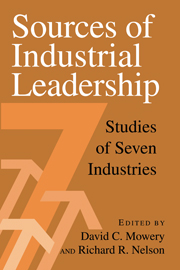Book contents
- Frontmatter
- Contents
- Acknowledgments
- List of Contributors
- 1 Introduction
- 2 The Evolution of Competitive Advantage in the Worldwide Semiconductor Industry, 1947–1996
- 3 Industrial Dynamics and the Evolution of Firms' and Nations' Competitive Capabilities in the World Computer Industry
- 4 The Computer Software Industry
- 5 Innovation in the Machine Tool Industry: A Historical Perspective on the Dynamics of Comparative Advantage
- 6 Dynamics of Comparative Advantage in the Chemical Industry
- 7 The Pharmaceutical Industry and the Revolution in Molecular Biology: Interactions Among Scientific, Institutional, and Organizational Change
- 8 Diagnostic Devices: An Analysis of Comparative Advantages
- 9 Explaining Industrial Leadership
- Index
6 - Dynamics of Comparative Advantage in the Chemical Industry
Published online by Cambridge University Press: 05 June 2012
- Frontmatter
- Contents
- Acknowledgments
- List of Contributors
- 1 Introduction
- 2 The Evolution of Competitive Advantage in the Worldwide Semiconductor Industry, 1947–1996
- 3 Industrial Dynamics and the Evolution of Firms' and Nations' Competitive Capabilities in the World Computer Industry
- 4 The Computer Software Industry
- 5 Innovation in the Machine Tool Industry: A Historical Perspective on the Dynamics of Comparative Advantage
- 6 Dynamics of Comparative Advantage in the Chemical Industry
- 7 The Pharmaceutical Industry and the Revolution in Molecular Biology: Interactions Among Scientific, Institutional, and Organizational Change
- 8 Diagnostic Devices: An Analysis of Comparative Advantages
- 9 Explaining Industrial Leadership
- Index
Summary
Introduction
The chemical industry is one the largest manufacturing industries in the world. In 1995, the sales of the U.S. chemical industry amounted to $372 billion, while those of Western Europe taken together amounted to $495 billion and the Japanese chemical industry, $252 billion. In terms of value added, chemicals and allied products account for about 10.4% of U.S. manufacturing output and 1.9% of the U.S. gross domestic product (GDP). Not only is the chemical industry very large, it is also very complex. In fact, the chemical processing industries (CPIs) group has been called the most miscellaneous of industries and the description is apt. The chemicals and allied products group (SIC 28) can be divided into three major subgroups: (1) basic chemicals such as acids, alkalis, salts, and organic chemicals; (2) intermediate chemical products such as synthetic fibers, plastic materials, and colors and pigments; (3) consumer chemical products such as drugs, cosmetics, soaps, as well as paint, fertilizers, and explosives. Even if one excludes closely related sectors such as refining, and paper and pulp, the CPI produce somewhere on the order of 50,000–70,000 products. Many of the products are new, the results of product innovation, but many older products survive, even if their relative importance has declined.
The most important class of chemicals are the organic compounds, which are much more pervasive and varied than the inorganic compounds, such as salt and minerals and products derived from them such as chlorine, bleach, caustic soda, and sulfuric acid.
- Type
- Chapter
- Information
- Sources of Industrial LeadershipStudies of Seven Industries, pp. 217 - 266Publisher: Cambridge University PressPrint publication year: 1999
- 6
- Cited by



